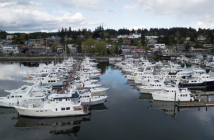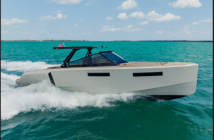You probably already know all this, but a fast refresher never hurts. Here’s some great advice from America’s Boating Compass, formerly the U.S. Power Squadrons, about how to make your way safely under bridges, a particular issue if you’re cruising in Florida or along the Great Loop. I just want to add that you definitely need to know how to maneuver your boat in close quarters; you’ll often find yourself waiting, with several other boats, for a bridge to open, perhaps while dealing with a current, and you have to stay out of each other’s way.
- Approach bridges slowly and cautiously to make sure your wake doesn’t create problems for other boats.
- Check maps and charts for the horizontal and vertical clearances of the center channel span as many inland lakes and rivers have no minimum bridge height.
- Refer to the clearance gauge affixed to the bridge’s right side upon approach to ensure your boat will clear the bridge. The gauge marks the distance between the bridge channel span and the waterline, not the water depth under the bridge.
- Pay attention to the bridge lights when navigating at night. A green light marks the center of the navigable channel under a bridge, and red lights mark supporting piers. Use the red lights to avoid the supporting piers, which you may be unable to see until it’s too late. Watch out for strong currents, exposed rock, and trapped debris.
- Contact the bridgetender to determine a drawbridge’s clearance. Use VHF Channel 13 or 16 (Channel 9 in Florida, Georgia or South Carolina) using the low power (1 watt) setting.
- Never ask for a bridge opening if your boat will fit under a closed bridge. Lower radio antennas and movable masts when necessary.
- Know how to signal bridgetenders when you can’t reach them on VHF. Request an opening with one long (4 to 6 seconds) and one short (1 second) blast. The bridgetender will return the signal if the bridge can be opened immediately. If the bridge cannot open or is closing, the tender will sound the danger signal: five short blasts.
- Avoid getting stuck between bridges by checking cruising guides or other local knowledge sources. Not all lift bridges open on demand or on a set schedule, and railroad drawbridges can stay down for hours. Use local knowledge to avoid getting stuck between a drawbridge and a railroad bridge while waiting for the latter to open. Read more: https://boatingcompass.org/navigating-bridges-by-boat/?mc_cid=a35b83850f&mc_eid=17593ea63d




